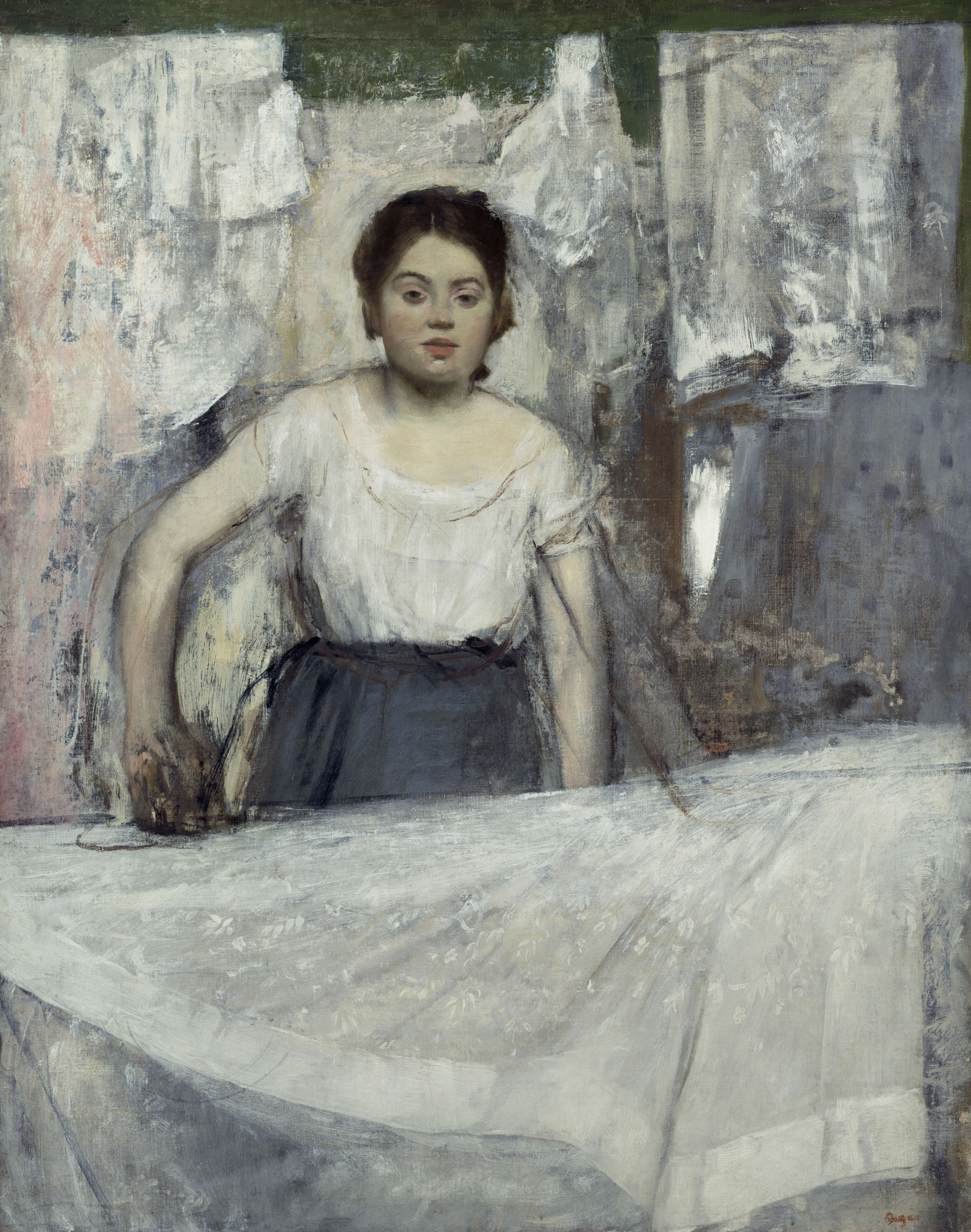
Degas and the Laundress: Women, Work, and Impressionism
Tags for: Degas and the Laundress: Women, Work, and Impressionism
- Special Exhibition
- Tickets Required
Sunday, October 8, 2023–Sunday, January 14, 2024
Location: 004 Special Exhibition Gallery
The Kelvin and Eleanor Smith Foundation Gallery
The Kelvin and Eleanor Smith Foundation Gallery
Woman Ironing (detail), c. 1869. Edgar Degas (French, 1834–1917). Oil on canvas; 92.5 x 73.5 cm. Neue Pinakothek, Bayerische Staatsgemäldesammlungen, Munich, 14310. Photo: bpk Bildagentur / Neue Pinakothek, Bayerische Staatsgemäldesammlungen, Munich / Art Resource, NY
About The Exhibition
This groundbreaking exhibition is the first to explore Impressionist artist Edgar Degas’s representations of Parisian laundresses. These working-class women were a visible presence in the city, washing and ironing in shops open to the street or carrying heavy baskets of clothing. Their job was among the most difficult and poorly paid at the time, forcing some laundresses to supplement their income through sex work. The industry fascinated Degas throughout his long career, beginning in the 1850s and continuing until his final decade of work. He created about 30 depictions of laundresses, a selection of which is united for the first time in this exhibition. The artworks from this series—revolutionary in their emphasis on women’s work, the strenuousness of such labor, and social class—were featured in Degas’s earliest and most significant exhibitions, where they were praised by critics as epitomizing modernity.
Degas and the Laundress contextualizes these works with paintings, drawings, and prints of the same subject by the artist’s contemporaries—including Gustave Caillebotte, Berthe Morisot, Pierre-Auguste Renoir, and Henri de Toulouse-Lautrec—as well as painters that he influenced and was influenced by, from Honoré Daumier to Pablo Picasso. It also presents ephemera, such as posters, photographs, and books, that reveals the widespread interest that Parisians of all social classes had in the topic of laundresses during the late 1800s.
The exhibition is accompanied by an interdisciplinary, richly illustrated publication featuring thematic essays by scholars of art history, literature, and history.
Docent-Led Exhibition Tours
Exhibition tours are offered at 3:30 p.m. Tuesdays, Fridays, and Sundays, as well as at 7:00 p.m. Wednesdays, October 17 through December 21; tickets required. Select “Tour 3:30 pm” or “Tour 7:00 pm” and your ticket quantity when reserving your exhibition ticket(s) and participate in the tour.
Featured Art
CMA Store
Nineteenth-Century French Drawings at the Cleveland Museum of Art

Degas and the Laundress: Women, Work, and Impressionism

Degas Dancer Animation Flipbook

The Ballet Class Wireless Charging Disk

Related Content
Degas and the Laundress: Women, Work, and Impressionism
Tags for: Degas and the Laundress: Women, Work, and Impressionism
- Book
- Online Store

The Labor of Parisian Laundresses
Tags for: The Labor of Parisian Laundresses
- Magazine Article
- Exhibitions
Impressionist artist Edgar Degas is best known today for his images of entertainments for the upper-middle class in 19th-century...

Reconsidering Degas
Tags for: Reconsidering Degas
- Magazine Article
- Exhibitions
For most people, the name Edgar Degas likely calls to mind images of the gracefully posed dancers who occupied the stage...

Degas and the Laundress: Thinking about the (In)visibility of Women’s Labor in Impressionism
Tags for: Degas and the Laundress: Thinking about the (In)visibility of Women’s Labor in Impressionism
- Blog Post
- Collection
- Exhibitions
For many, the word Impressionism conjures images of light-filled landscapes, ballerinas, or fashionably dressed women at...

Sponsors
Principal support is provided by Hahn Loeser & Parks LLP. Major support is provided by the John P. Murphy Foundation. Additional support is provided by Christie’s, the FRench American Museum Exchange (FRAME), Carl M. Jenks, Mr. and Mrs. Frank H. Porter Jr., and the Simon Family Foundation, a supporting foundation of the Jewish Federation of Cleveland.
Image

Image

Image

This exhibition is supported by an indemnity from the Federal Council on the Arts and the Humanities.
All exhibitions at the Cleveland Museum of Art are underwritten by the CMA Fund for Exhibitions. Principal annual support is provided by Michael Frank and the late Pat Snyder, the John and Jeanette Walton Exhibition Fund, and the late Roy L. Williams. Generous annual support is provided by an anonymous supporter, the late Dick Blum and Harriet Warm, Gary and Katy Brahler, Cynthia and Dale Brogan, Dr. Ben and Julia Brouhard, Brenda and Marshall Brown, Richard and Dian Disantis, the Jeffery Wallace Ellis Trust in memory of Lloyd H. Ellis Jr., Leigh and Andy Fabens, the Frankino-Dodero Family Fund for Exhibitions Endowment, Janice Hammond and Edward Hemmelgarn, Carl T. Jagatich, Eva and Rudolf Linnebach, William S. and Margaret F. Lipscomb, Bill and Joyce Litzler, Lu Anne and the late Carl Morrison, Jeffrey Mostade and Eric Nilson and Varun Shetty, Tim O’Brien and Breck Platner, William J. and Katherine T. O’Neill, Michael and Cindy Resch, Betty T. and David M. Schneider, the Kelvin and Eleanor Smith Foundation, Margaret and Loyal Wilson, the Womens Council of the Cleveland Museum of Art, and Claudia Woods and David Osage.